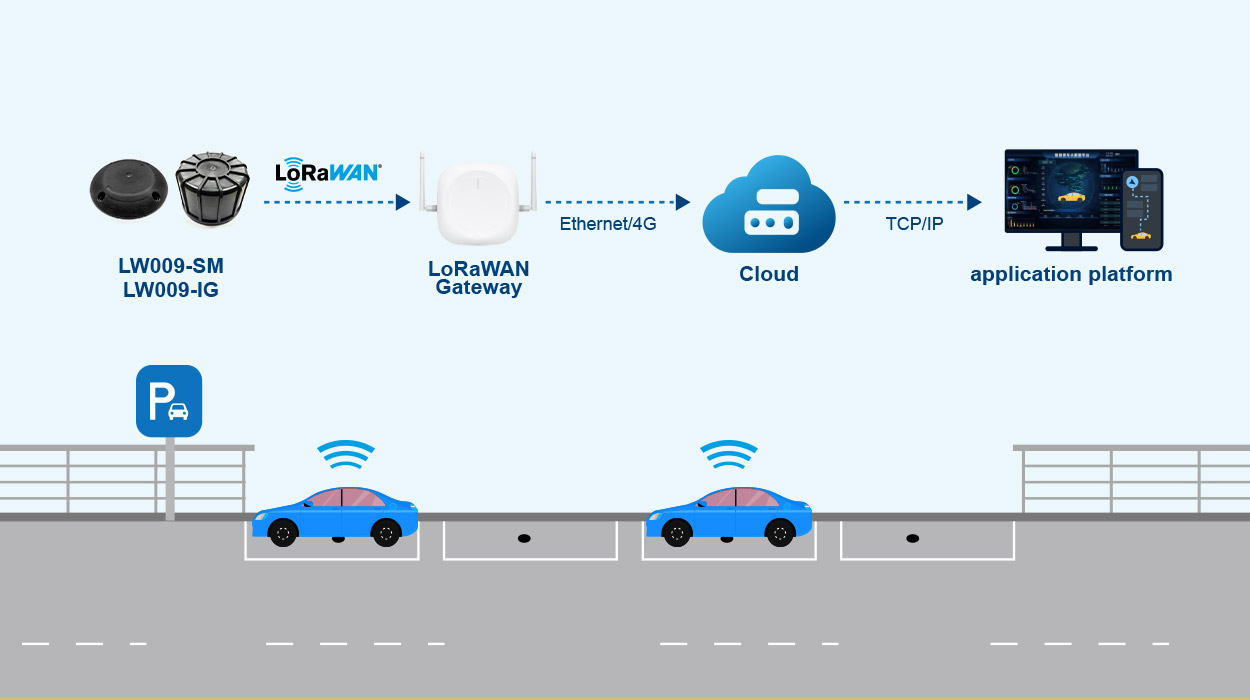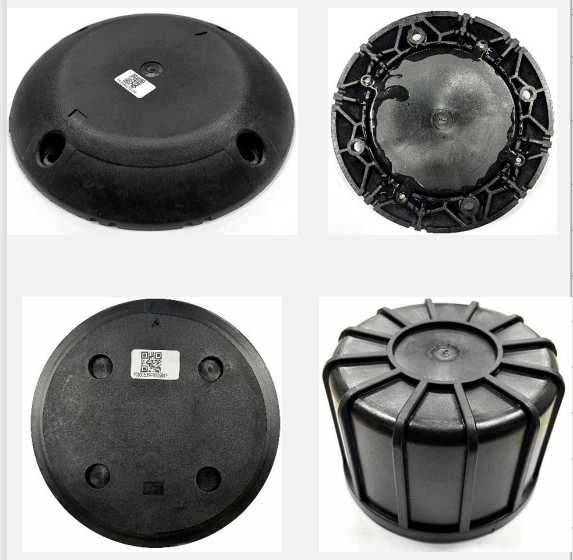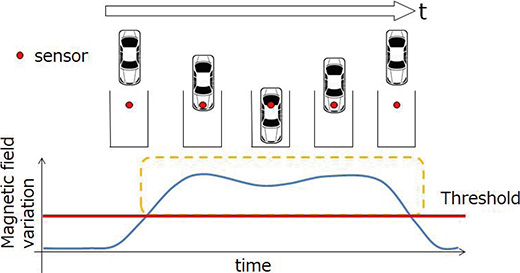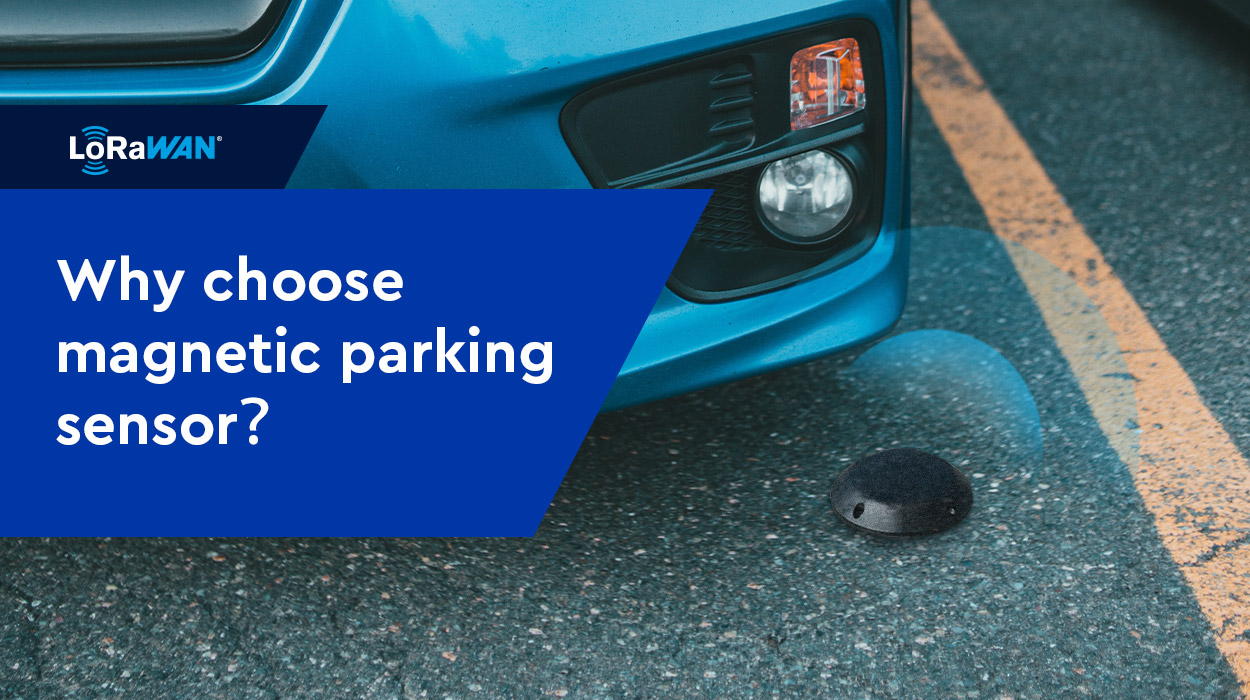With the rise of the global economy, it is more and more common to use cars as a daily means of transportation, which also causes the problems of traffic jams and a shortage of parking spaces. Robust and reliable parking detection is the key technology of an intelligent parking management system. At present, smart parking sensor has been widely used in parking detection. Based on the current market trend of smart parking, this article will focus on wireless geomagnetic vehicle detection technology and other related smart parking systems.
Market analysis of parking sensor
In recent years, there has been a proliferation of systems designed to provide drivers with a variety of road information and to exchange information between roads and vehicles. These systems mainly show congestion in parking lots and direct users to free locations in real-time. Mainly applicable to parking lots in urban areas (such as metered parking lots, parking facilities in apartment buildings, etc.) and highway rest stops, these smart parking systems not only narrow the congestion gap but also further promote the realization of an autonomous driving society.
The parking sensor market is evaluated to grow significantly between 2021 and 2027. It is expected to reach $6625.16 million by 2025, representing a CAGR of 24.3%. Among the various smart parking sensor technologies, ultrasonic sensors generate the highest revenue, followed by magnetic parking sensors. In addition, Europe has the largest share, accounting for approximately 41.1% of the total market share and generating $722 in revenue, which is expected to grow at a CAGR of 22.9%, followed by Asia Pacific. The urgent need to solve the problem of parking space allocation in modern cities is the prominent trend of accelerating the expansion of the smart parking sensor market. The rapid development of communication technology has promoted the efficient development of low-cost intelligent parking sensors. Regionally, the APAC parking sensor industry is expected to take a significant share in 2027. This can be credited to countries such as China and India gradually easing coronavirus restrictions, giving retail car salesrooms to grow significantly. In addition, the rapid establishment of smart parking systems is expected to further drive the demand for parking sensors in the region.
The popularity of wireless parking sensors is an inevitable trend
A stable smart parking system needs sensors to determine the availability of parking lots and individual parking spaces, and it needs to be easy to install and maintain. Loop coil type and ultrasonic type have quite high vehicle detection accuracy, but they need to dig the road surface and wiring, and it is difficult to flexibly respond to the change of parking space. Although the image sensor can detect multiple parking spaces with only one camera, its parameters need to be adjusted during installation, and its environmental tolerance is not good, so it needs to be maintained frequently. On the other hand, with the reduction of the power consumption of wireless sensors and the miniaturization of equipment, as well as the extension of battery life, it is possible to detect in a completely wireless environment. There are many kinds of wireless parking sensors based on different IoT technology. We have also done a lot of market research, and according to our existing development technology, we have developed two wireless geomagnetic vehicle sensors using energy-saving geomagnetic detection components and a radar detector.
If where you live is not in a hostile environment, LW009 from MOKOSMART is a preferred magnetic parking sensor for you. You can use a more energy-efficient geomagnetic detector and turn on the radar to verify parking events.
What is a magnetic parking sensor?
Magnetometers can be wired or wireless, this article will focus on wireless magnetometers. A geomagnetic vehicle detector is a sensor based on the magnetic flux density to detect the changes in the geomagnetic field and the surrounding magnetic environment. With this feature, it can detect the surrounding magnetic body. The movement of the magnet located at the height of the furthest vehicle from the ground can be detected as the change from the sensor installed on the road.
Working principle of magnetic parking sensor
Wireless magnetic sensors are designed for on-street and off-street parking devices. When the vehicle is parked on top of the magnetic parking sensor, the sensor responds to changes in the Earth’s magnetic field and transmits the parking availability information to the parking management system in real-time. The smart parking system displays the number of available parking spaces on an LED screen.

Structure of magnetic parking sensor
The sensors are installed on the road surface of the parking space. In order to resist the impact of the vehicle, our magnetic parking sensors are made of an impact-resistant shell with thickness and an external structure to ensure that the vehicle will not break even if it is run over. The bearing weight is up to 10 tons. Our LW009 is equipped with geomagnetic detection components, a radar detector, a processing CPU, a radio substrate, and a built-in battery to achieve complete wireless connection and miniaturization. Eliminates the need to route power for data acquisition and makes sensor installation easier.

Magnetic parking vehicle detection algorithm
“Magnetic field variation” varies according to vehicle type and vehicle segment. However, regardless of the vehicle type, the “magnetic field variation” displayed by the engine section far exceeds that of vehicles parked in adjacent parking spaces. Magnetic parking sensors should be placed one-third of the way in front of the parking space. The sensor can detect parked vehicles with high accuracy regardless of parking mode and vehicle type. The detection rate is 100%, which is comparable to or higher than other traditional types of parking sensors. The algorithm is designed based on data obtained from the results of experiments carried out on various types of vehicles. Using a wireless geomagnetic vehicle sensor equipped with the algorithm, the engine portion of the vehicle can be reliably identified, thus detecting the vehicle with high precision.

Benefits
The magnetic parking sensor is a cost-effective intelligent parking solution. It does not require wiring and can achieve accurate and repeatable responses. In addition, wireless magnetometers have compact enclosures that can be installed on or below the ground, making them much cheaper to install than other technologies, and making them easier to debug. In addition, the wireless magnetometer is packaged in a strong epoxy resin with a water resistance rating of up to IP68, making its performance impermeable even in severe weather conditions. In addition, there are many wireless communication modes supported by the wireless magnetometer, which means that the wireless magnetic parking sensor can be used in many applications. Finally, most of its batteries are also removable and typically last up to five years.
Challenge
Although the magnetic parking sensor has proven to be a preferred parking sensor, there are some challenges. For example, high-clearance vehicles such as trucks, SUVs, and vans are difficult to detect, even a standard car has “blind spots” in magnetic field distortion, and is susceptible to interference from subway trains and power lines. Also, electric cars made of carbon fiber and non-ferrous metals may be harder to detect.

What is a radar ranging sensor?
Radar sensors are ideal for remote outdoor applications and can detect the presence of vehicles using radio signals and laser reflection, independent of conditions such as rain, wind, fog, humidity, and air temperature. Many sensors can also be configured to detect objects at specified distances for greater accuracy. Generally, it can provide accurate results within 7 meters, but its accuracy decreases at longer distances and sharper reflection angles, so the power sensor fixed to the lamp post can only reliably cover 4-5 parking spaces. Generally speaking, radar ranging has its own advantages and disadvantages compared with IR ToF sensors.
Let’s first look at the advantages:
- At the lower frequencies of 15-20 GHz, these sensors may be less sensitive to some thin obstacles and will work as usual under snow cover of up to 2cm.
- It has a wider beam, so it is not prone to a random reflection of IR.
The disadvantages are as follows:
1. The use of the equipment may require specialized knowledge of high-frequency circuit design.
2. Radar signal processing requires higher MCU processing power
Features of MOKOSMART magnetic parking sensor
- Dual-mode sensor detection provides a high accuracy of 99%
- LoRaWAN-based transmission can reach distances of up to 500 meters
- No wiring, easy installation
- Flip the switch via Bluetooth
- Available in the mobile app
- Parameters can be pre-configured and support OTA
- The battery is easy to replace and lasts up to five years.
- The IP68 protection rating enables it to withstand extremely hot and cold temperatures (-40 /+85ºC).
- Low current consumption, usually in the sampling rate range of 20 to 38 uA/1Hz.
- Structural design of removable sleeve (LW009-IG only)
Extra features for LW009-SM
- A built-in temperature and humidity sensor can be used to measure whether the road is icy
- An external mounting bracket is available to avoid drilling
- Reflective warning stickers enhance visibility and avoid any inadvertent accidents
Applications of wireless parking sensor
The smart parking IoT project creates a more efficient public service space, which can be specifically seen in the following aspects:
- Reduce at least 50% of the time to find a parking space to ease congestion
- Make real-time adjustments to the public transportation route
- Guide drivers navigate to the available parking spaces and optimize the use of all the parking space
- Strengthen street ticketing system of operation, increase ticket sales
- Protect the disabled parking spaces, taxis, and other special parking with our vehicle detection
- Make smarter parking lot management planning through historical data analysis
Compare different Vehicle Detection Technologies
Ultrasonic sensor
Wireless ultrasonic sensors that use sound waves to detect objects are ideal applications in indoor parking lots. They can be mounted directly on the ceiling of the parking lot. Any object, regardless of the size, angle, or shape of the reflection, will be detected by the sensor as long as it passes between the surface and different points of the sensor.
Optical sensor Infrared
Optical sensors are also a technology that can be used for vehicle detection, though less so than other technologies. To detect objects, anti-mode optical sensors use interrupted beams of light between the transmitter and receiver. For instance, when a car passes between the receiver and transmitter, the beam can be interrupted so that it can be determined whether a car has completely left the car wash.
Measuring light grid
Many toll booths use a measuring light grid to start and terminate transactions. On either side of the toll lane, a transmitter and a receiver would be placed on an array of beams crossing the toll lane, and data from each beam could be used to identify the class and number of vehicles.

The development and extension of the parking sensor industry
Autonomous vehicle technology is getting more mature, but there are still a lot of concerns, smart parking systems are our opportunity to transition to a fully autonomous society, and this can be reflected in a variety of applications.
- For example, the autonomous driving function of the autonomous vehicle detects that there is a car parked near the entrance of the parking lot. In this case, the sensor can be used to inform the autonomous vehicle that there is a parked or moving vehicle based on the driving direction and parking duration.
- In addition, the measurement of traffic flow is also an important direction. By placing this sensor in the parking lot and main roads, the number of vehicles can be counted to facilitate traffic management.
- By placing two wireless geomagnetic vehicle sensors, the driving direction can be estimated based on the detection time difference.
- Add new sensor modules such as acceleration sensors, which can be used to determine the type of vehicle triggered by the detection results of geomagnetic detection elements.
Continue Reading About Vehicle Detection
























